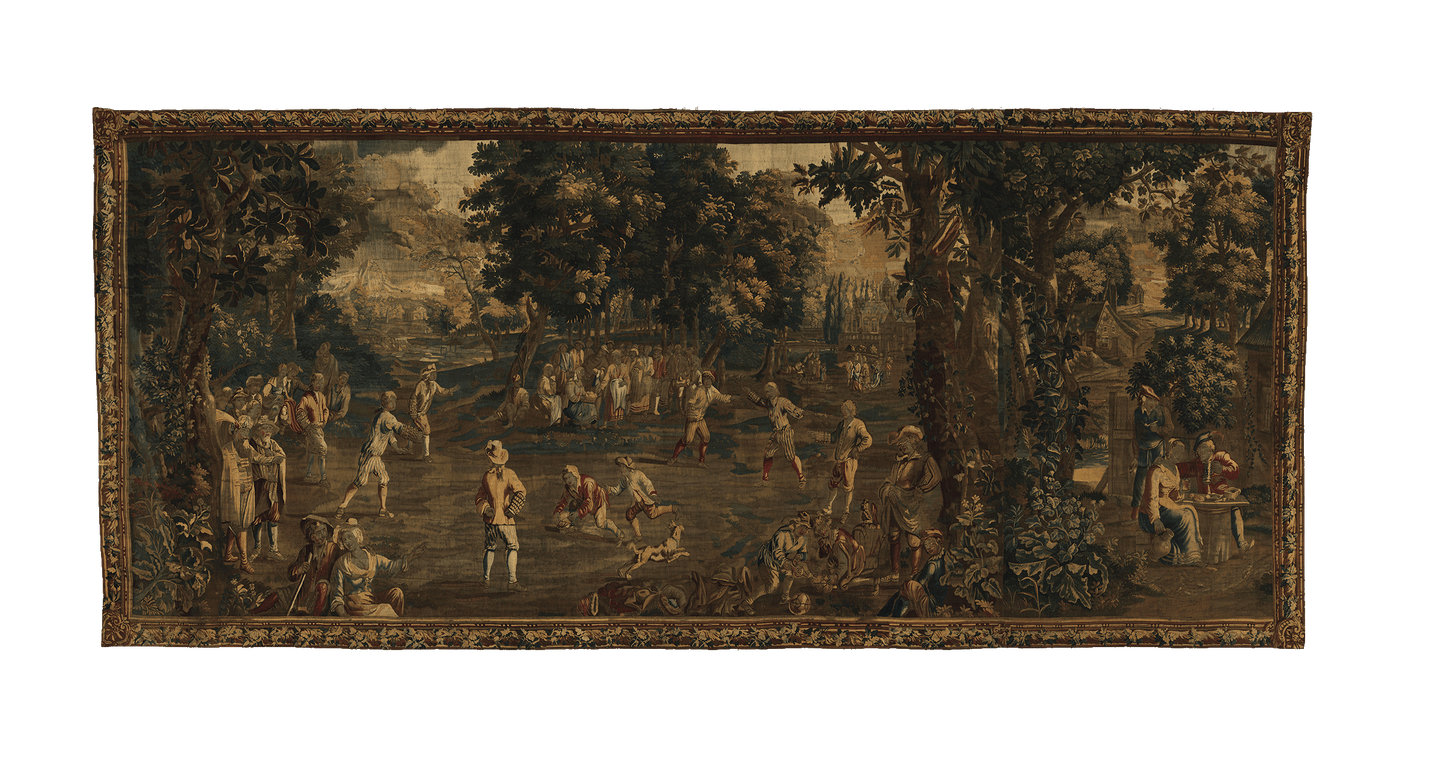Romantic English
The Pastoral Fête: A Celebration of Country Life RE396483
The Pastoral Fête: A Celebration of Country Life RE396483
Couldn't load pickup availability
Ah, what a delightful and expansive scene we have before us! This tapestry is a veritable window into the pastoral pleasures of a bygone era, a celebration of leisure and the simple joys of life. Allow me to guide you through this charming landscape, as if we were strolling through the very fields depicted here.
Foreground and Main Scene: This tapestry is an enchanting portrayal of a grand outdoor gathering, possibly a fête or festival, set in the idyllic countryside. The scene is filled with an array of figures, all engaged in various activities that exude a sense of joy, relaxation, and camaraderie. The figures are dressed in the attire of the 17th or 18th century—flowing coats, breeches, and wide-brimmed hats for the gentlemen; elegant, flowing gowns for the ladies—each garment rendered with exquisite attention to detail.
At the center of the scene, a group of dancers takes the stage, moving with grace and energy, their bodies caught mid-motion. The dance appears to be one of those lively country dances that were popular in rural festivities, where the participants, hands joined, weave intricate patterns as they move. The energy of the dancers is palpable, their movements animated yet harmonious, embodying the spirit of the celebration.
To the left, we see a group of musicians, likely providing the lively tune to which the dancers move. They are partially obscured by the foliage, yet their presence is crucial, adding a layer of auditory imagination to the visual feast. The soft strumming of a lute, the lilting notes of a flute, and the rhythmic tapping of a tambourine can almost be heard as we take in the scene.
Background and Setting: The background reveals a lush, green landscape, dotted with trees whose leaves form a natural canopy over the festivities. The trees are rendered with a delicate touch, their leaves and branches creating a tapestry of their own against the blue sky. The light filters through the leaves, casting dappled shadows on the ground, which is covered with soft grass and wildflowers—a perfect setting for such a jovial gathering.
Further back, the tapestry reveals a quaint village, its rooftops just visible above the treetops. The village, with its charming cottages and perhaps even a small manor house, suggests that this scene takes place in the heart of the countryside, far from the bustle of the city. The setting evokes a sense of peace and contentment, a world where the complexities of life are forgotten, if only for a day.
The Festivities: Beyond the dancers and musicians, we see groups of people engaged in various leisurely activities. Some are seated on the grass, enjoying a picnic, their baskets brimming with the bounty of the land. Others stand in small clusters, engaged in animated conversation, their faces lit with laughter and mirth. Children play nearby, their carefree movements a testament to the joy and freedom of youth.
To the right, a table is set up, where a group of gentlemen appears to be engrossed in a game of cards or dice, their expressions a mix of concentration and amusement. The inclusion of this scene adds a touch of the playful rivalry that often accompanies such gatherings, a reminder that even in leisure, a hint of competition can add to the fun.
Border: The border of the tapestry is adorned with a profusion of flowers, vines, and perhaps small animals—a celebration of nature that mirrors the scene within. The colors are warm and earthy, with shades of green, gold, and burgundy predominating, creating a frame that both contains and complements the lively scene it surrounds.
Color and Technique: The colors of this tapestry are somewhat muted, likely softened by time, yet they still convey the warmth and richness of the scene. The greens of the foliage, the earthy browns of the ground, and the soft pastels of the figures’ clothing all blend harmoniously, creating a sense of unity and coherence. The artist has employed a delicate hatching technique to create depth and texture, particularly in the trees and the figures’ clothing, giving the tapestry a lifelike quality that draws the viewer into the scene.
The weaving itself is masterful, with fine details in the figures’ expressions, the drape of their clothing, and the intricate patterns of the foliage. The tapestry was likely produced in a renowned workshop, perhaps in Flanders or France, where such pastoral scenes were highly popular during the 17th and 18th centuries. The craftsmanship speaks of a time when tapestries were not merely decorative, but narrative pieces that told stories of daily life, of ideals, and of a simpler, more connected existence.
Interpretation: "The Pastoral Fête" is more than just a depiction of a rural celebration—it is an idealized vision of the pastoral life, a celebration of nature, community, and the simple pleasures that bind people together. It reflects the Romantic ideal of the countryside as a place of peace and contentment, where life follows the natural rhythms of the seasons and where people live in harmony with the land and with each other.
In conclusion, this tapestry is a captivating portrayal of a world where joy is found in the company of others and in the beauty of the natural world. It is a piece that would have brought warmth and a sense of nostalgia to any room in which it was displayed, reminding its viewers of the enduring appeal of the pastoral life.


